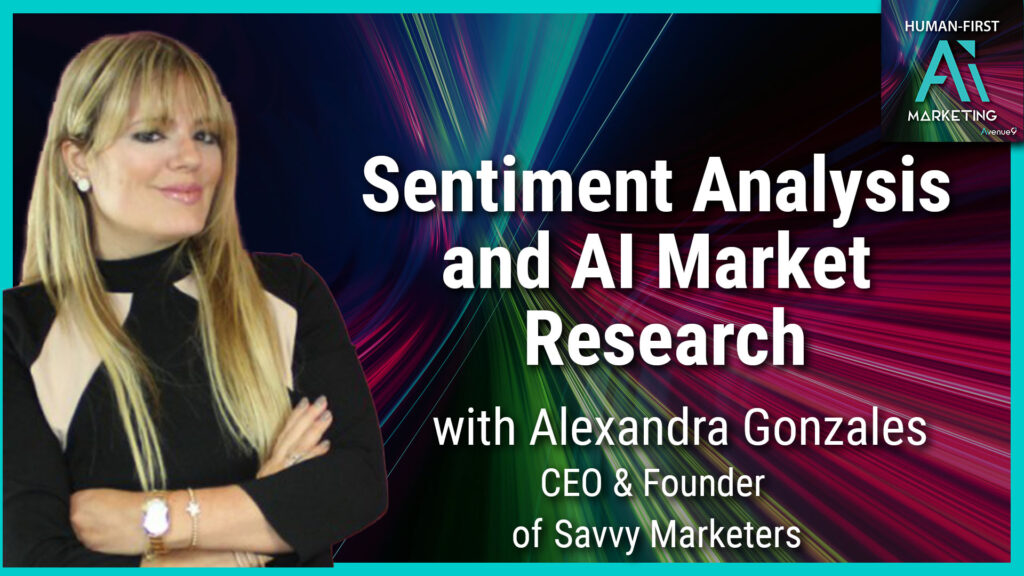orget clicks. What your customers feel matters more than what they say or do. In this episode, Alexandra Gonzalez of Savvy Marketers joins us to explore how sentiment analysis, facial recognition, and biometric data can reveal the emotional truth behind your marketing. We dig into why 93% of communication happens beyond words, how to uncover hidden emotional signals in your campaigns, and how SMB marketers can apply neuroscience, not guesswork, to craft messages that actually resonate.
You’ll hear why some big brands went viral for the wrong reasons, how to avoid tone-deaf campaigns, and why putting your customer at the center of your strategy is both smart and human-first. Whether you’re working with a lean team or looking for smarter ways to validate messaging before launch, this conversation will shift how you think about “engagement.” The future of marketing isn’t more noise; it’s a deeper connection. Let’s talk about how AI can help you get there.
If you’re still chasing likes, clicks, and “engagement rates” as proof your marketing is working, this post is for you.
I recently sat down with Alexandra Gonzalez, a 25-year market research veteran and founder of Savvy Marketers, for a powerful conversation on our Human-First AI Marketing podcast. We dug into the science behind emotional intelligence in marketing and how AI, when used the right way, can uncover truths even your best customers won’t say out loud.
Here’s the short version: attention is cheap affinity is everything.
Are You Listening to the Wrong 93%?
Alexandra shared a stat that stopped me in my tracks: only 7% of emotion is communicated through words. The rest? Tone, facial expression, and nonverbal cues.
Yet most businesses rely almost entirely on word-of-mouth surveys, polls, and reviews to understand how their audience feels. That’s like trying to read a book with the last few chapters torn out.
If you’re not using tools that analyze sentiment, expression, and engagement, you’re not reading the full story. You’re reacting to symptoms, not diagnosing the root cause.
Human-First takeaway: Use tools that go beyond “what they said” to uncover “what they meant.”
The Danger of Gut Instinct (and Why Big Brands Still Blow It)
Marketing directors at small companies often say, “We don’t have budget for research, we just go with what feels right.”
Fair, but here’s the twist: multi-billion-dollar brands with full research budgets still mess it up. Pepsi, Bud Light, and others launched campaigns that looked beautiful and diverse on paper… but totally missed the emotional tone of the moment.
The result? Viral backlash. Lost market share. Layoffs. Why? They never tested the message with the people they were trying to reach.
Lesson for SMBs: Your gut might be good, but it’s not scalable. Use AI to simulate real reactions before you launch.
AI Isn’t Here to Replace You. It’s Here to Read the Room for You.
A lot of people worry that AI doesn’t understand emotions. Alexandra says that’s true, but also kind of misses the point.
Humans can misread a room. We bring bias, assumptions, and fatigue. AI, when used with emotional intelligence and ethical guidance, can spot micro-reactions and patterns we can’t. That makes your creative stronger, not weaker.
Here’s the metaphor I shared: AI is your mirror, not your makeup. It reflects what’s there; it’s your job to show up real.
Human-First takeaway: Don’t hand the mic to AI, use it as a second set of eyes and ears.
Clicks Are Not Customers. Engagement Is Not Affinity.
This one hit close to home. Alexandra told the story of clicking on an article about a rival college’s basketball player getting arrested, not out of support, but out of schadenfreude. Hate-click.
Next thing she knows, she’s bombarded with more of that school’s content. Algorithms assumed she was a fan.
We’ve all seen this: you post something controversial and it “performs well”… but it doesn’t convert. That’s because it’s easy to stir up attention. It’s harder, but far more profitable, to earn trust and affinity.
Human-First takeaway: Engagement metrics don’t equal connection. Look for emotional alignment, not just reactions.
It’s Not AI or Humans. It’s Humans with AI.
At Avenue9, we believe the future belongs to brands that honor the human in the data. AI can help us scale our impact, sharpen our message, and predict what’s coming, but only when it’s guided by marketers who care.
Alexandra runs research labs where humans watch the interviews behind a two-way mirror while AI analyzes facial expressions. That’s the vision. Smart tools. Empathetic humans. Better stories.
If you’re a small marketing team trying to do big things with limited resources, this is the edge: combine the emotional intelligence of humans with the speed and objectivity of AI.
What to Do Next
Want to hear how Alexandra’s client saved millions by adjusting just a few seconds of a campaign before going live?
Curious how to start emotionally testing your marketing without breaking your budget?
🎧 Listen to the full episode: Affinity Over Attention: Using AI to Create Meaningful Brand Connections
Subscribe to the Human-First AI Marketing Podcast →


